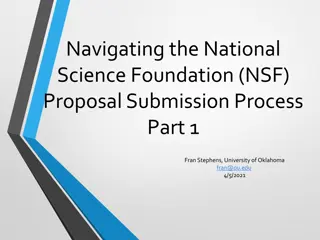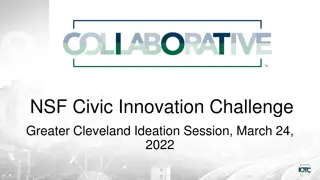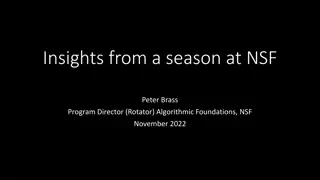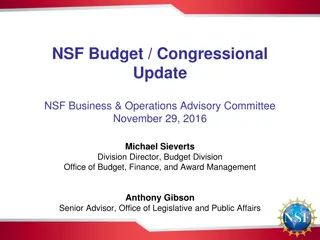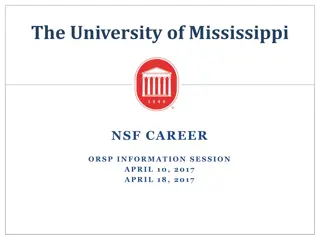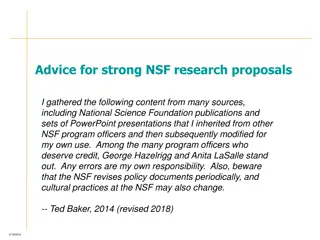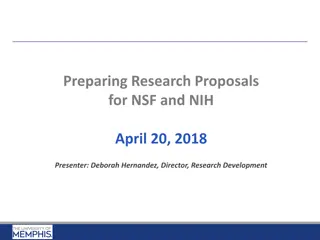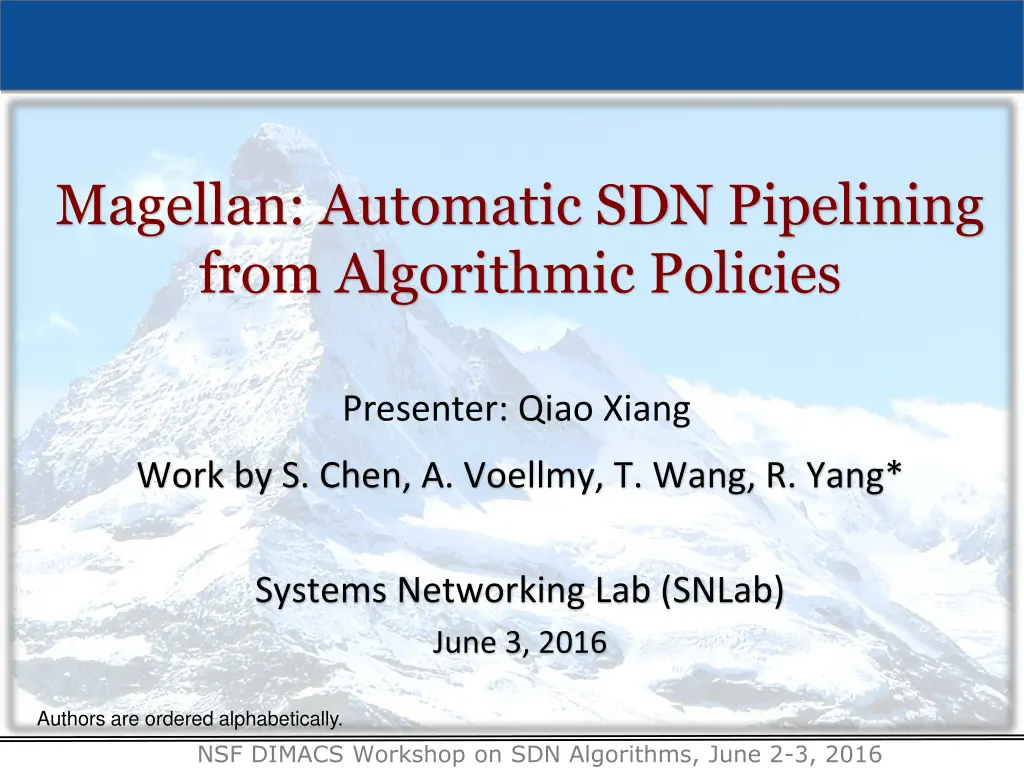
Automatic SDN Pipelining from Algorithmic Policies by Magellan
Explore the innovative approach of automating SDN pipelining from algorithmic policies presented by Magellan. Learn about high-level algorithmic SDN programming, challenges, examples in Java, and more from this research work.
Download Presentation

Please find below an Image/Link to download the presentation.
The content on the website is provided AS IS for your information and personal use only. It may not be sold, licensed, or shared on other websites without obtaining consent from the author. If you encounter any issues during the download, it is possible that the publisher has removed the file from their server.
You are allowed to download the files provided on this website for personal or commercial use, subject to the condition that they are used lawfully. All files are the property of their respective owners.
The content on the website is provided AS IS for your information and personal use only. It may not be sold, licensed, or shared on other websites without obtaining consent from the author.
E N D
Presentation Transcript
Magellan: Automatic SDN Pipelining from Algorithmic Policies Presenter: Qiao Xiang Work by S. Chen, A. Voellmy, T. Wang, R. Yang* Systems Networking Lab (SNLab) June 3, 2016 Authors are ordered alphabetically. NSF DIMACS Workshop on SDN Algorithms, June 2-3, 2016
Outline Background: algorithmic SDN programming Maple Magellan Summary NSF DIMACS Workshop on SDN Algorithms, June 2-3, 2016 2
Background: High-Level Algorithmic SDN Programming Goal: Can we let programmers write the most obvious SDN code? consider each pkt as a request - Network control expressed in general purpose language, (logically) invoked on each pkt - A network control function returns how a pkt traverses network, not how datapath (flow tables) are configured. NSF DIMACS Workshop on SDN Algorithms, June 2-3, 2016 3
Example Algorithmic Policy in Java Route f(Packet p) { if (p.tcpDstIs(22)) return null(); else { Location sloc = hostTable(p.ethSrc()); Location dloc = hostTable(p.ethDst()); Route path = myRoutingAlg(topology(), sloc,dloc); return path; } } Route myRoutingAlg(Topology topo, Location sLoc, Location dloc) { if ( isSensitive(sLoc) || isSensitive(dLoc) ) return secureRoutingAlg(topo, sloc, dloc); else return standardRoutingAlg(topo, sloc, dloc); } Does not specify anything on flow tables! NSF DIMACS Workshop on SDN Algorithms, June 2-3, 2016 4
Challenge Na ve solution of processing each packet at controller is not possible Key challenge: How to use data-path (flow tables) from data-path oblivious algorithmic policies? NSF DIMACS Workshop on SDN Algorithms, June 2-3, 2016
Outline Background: algorithmic SDN programming Maple: dynamic tracing NSF DIMACS Workshop on SDN Algorithms, June 2-3, 2016 6
Maple: Basic Idea There are two representations of computation A sequence of instructions Memorization tables Although the decision function f does not specify how flow tables are configured, if for a given decision (e.g., drop), we know the dependency of the decision, we can construct the flow tables (aka, memorization tables). NSF DIMACS Workshop on SDN Algorithms, June 2-3, 2016 7
Maple: Realizing the Basic Idea Only requirement: Program f uses a simple library to access pkt attributes: Library provides both convenience and more importantly, decision dependency! NSF DIMACS Workshop on SDN Algorithms, June 2-3, 2016 8
Dynamic Tracing: Abstraction to Flow Tables 1. Observes decision dependency of f on pkt attributes. 2. Builds a trace tree (TT), a universal (general), partial decision tree representation of any f. 3. Compile trace tree to generate flow tables (FTs). NSF DIMACS Workshop on SDN Algorithms, June 2-3, 2016 9
Policy EthSrc:1, EthDst:2, TcpDst:80 Route f(Packet p) { Assert: TcpDst==22 if (p.tcpDstIs(22)) return null(); false else { Read: EthSrc Location sloc = hostTable(p.ethSrc()); 1 Location dloc = hostTable(p.ethDst()); Read: EthDst 2 Route path = myRoutingAlg( topology(),sloc,dloc); return path; } } path1 NSF DIMACS Workshop on SDN Algorithms, June 2-3, 2016 10
Trace Tree Policy EthDst:1, TcpDst:22 Route f(Packet p) { Assert: TcpDst==22 Assert: TcpDst==22 if (p.tcpDstIs(22)) true true false return null(); null else { Location sloc = hostTable(p.ethSrc()); Read: EthSrc ? 1 Location dloc = hostTable(p.ethDst()); Read: EthDst Route path = myRoutingAlg( topology(),sloc,dloc); return path; } } 2 path1 NSF DIMACS Workshop on SDN Algorithms, June 2-3, 2016 11
Trace Tree Policy EthDst:1, TcpDst:22 Route f(Packet p) { Assert: TcpDst==22 Assert: TcpDst==22 if (p.tcpDstIs(22)) true true false return null(); null else { Location sloc = hostTable(p.ethSrc()); Read: EthSrc null 1 Location dloc = hostTable(p.ethDst()); Read: EthDst Route path = myRoutingAlg( topology(),sloc,dloc); return path; } } 2 path1 NSF DIMACS Workshop on SDN Algorithms, June 2-3, 2016 12
Trace Tree => Flow Table tcpDst ==22 True False ethDst drop match:{tcpDst==22} 4 2 drop ethSrc match:{tcpDst!=22, ethDst:2} 6 port 30 match:{tcpDst!=22, ethDst:4,ethSrc:6} NSF DIMACS Workshop on SDN Algorithms, June 2-3, 2016 13
Trace Tree => Flow Table tcpDst ==22 True False ethDst drop match:{tcpDst==22} 4 2 drop ethSrc match:{tcpDst!=22, ethDst:2} 6 port 30 barrier rule: match:{tcpDst!=22, ethDst:4,ethSrc:6} match:{tcpDst==22} action:ToController Priority NSF DIMACS Workshop on SDN Algorithms, June 2-3, 2016 14
Trace Tree => Flow Table Simple, classical in-order tree traversal generates flow table rules! tcpDst ==22 3 1 True False 2 ethDst drop match:{tcpDst==22} 4 2 drop ethSrc match:{tcpDst!=22, ethDst:2} 6 port 30 barrier rule: match:{tcpDst!=22, ethDst:4,ethSrc:6} match:{tcpDst==22} action:ToController Priority NSF DIMACS Workshop on SDN Algorithms, June 2-3, 2016 15
Problems of Maple Trace Tree Quality: Compiles to only a single flow table Latency: A reactive approach that waits for punted packets to begin unfolding the trace tree and generating rules NSF DIMACS Workshop on SDN Algorithms, June 2-3, 2016 16
Why is Multi-Table Important for Quality (A Simple GBP Example)? Map<MAC, ConditionSet> hostTable; 0. Route onPacketIn(Packet p) { 1. ConditionSet srcCond = hostTable.get( p.ethSrc() ); 2. ConditionSet dstCond = hostTable.get( p.ethDst() ); 3. if (srcCond != null && dstCond != null && pass(srcCond, dstCond) ) 4. return port1; 5. else 6. return drop; } - - Assume n hosts in hostTable TT after pingall among the n hosts Flow table from trace tree ethSrc ethDst Action ethSrc a1 a1 a1 .. a1 a2 p1 p2 ethDst ethDst a1 a1 an an an an pn2 n2 entries; more if under attacks p pn2 p1 pn NSF DIMACS Workshop on SDN Algorithms, June 2-3, 2016 17
More Efficient Multi-Table (2 Tables) Design Table 1 Assume k condition possibilities. ethSrc Action a1 a2 .. regsrcCond=y1 jump 2 regsrcCond=y2 jump 2 an otherwise regsrcCond=yn jump 2 drop Table 2 regsrcSw y1 y1 .. ethDst Action a1 a2 p1,1 p1,2 n + kn entries yk otherwise an pk,n drop NSF DIMACS Workshop on SDN Algorithms, June 2-3, 2016 18
More Efficient Multi-Table (3 Tables) Design Assume k condition possibilities. Table 1 ethSrc Action Table 3 a1 a2 .. regsrcCond=y1 jump 2 regsrcCond=y2 jump 2 regsrcCond regsdstCond Action y1 y1 .. y1 y2 p1,1 p1,2 an otherwise regsrcCond=yn jump 2 drop yk otherwise yn pk,k drop Table 2 ethDst Action 2n + k2 entries a1 a2 .. regdstCond=y1 jump 3 regdstCond=y2 jump 3 an otherwise regdstCond=yn jump 3 drop NSF DIMACS Workshop on SDN Algorithms, June 2-3, 2016 19
Comparison of 3 Designs Assume n = 4000, k = 100 Design #flow rules 1 table 16,000,000 = 16M 2 tables 4000+400,000 = 404K 8000+10,000 = 18K 3 tables NSF DIMACS Workshop on SDN Algorithms, June 2-3, 2016 20
Outline Background: algorithmic SDN programming Maple Magellan: automatic SDN pipelining NSF DIMACS Workshop on SDN Algorithms, June 2-3, 2016 21
Magellan: Basic Idea Basic idea: Trace tree is a mostly blackbox approach, while Magellan starts with the other extreme---a whitebox approach. Proactively explore the program and generate flow tables NSF DIMACS Workshop on SDN Algorithms, June 2-3, 2016 22
Basic Insight: Per-Instruction Table (PIT) Function f consists of a sequence of instructions I1, I2, , IN One can consider each instruction I a table: a mapping from input variable states to output variable states, represented as a table InVar(I)1 InVar(I)2 InVar(I)3 OutVar(I) 1 1 1 OutVar(I)=I(1,1,1) InVar(I)1 OutVar(I) InVar(I)2 I InVar(I)3 NSF DIMACS Workshop on SDN Algorithms, June 2-3, 2016 23
Example Map<MAC, ConditionSet> hostTable; Route onPacketIn(Packet p) { I1. ConditionSet srcCond = hostTable.get( p.ethSrc() ); I2. ConditionSet dstCond = hostTable.get( p.ethDst() ); I3. branch [srcCond != null && dstCond != null && pass(srcCond, dstCond) ] I4 I5 I4. return port1 I5. return drop I3 I2 I1 regsrcCond regdstCond Action p.ethDst Action p.ethSrc Action RegdstCond =dstCond1 jump I3 1 RegsrcCond =srcCond1 jump I2 srcCond1 dstCond jump I4 1 1 jump I5 2 2 ... ... 248 RegdstCond =dstCond2^48 jump I3 248 RegsrcCond =srcCond2^48 jump I2 NSF DIMACS Workshop on SDN Algorithms, June 2-3, 2016 25
Problems of PIT Too large table size: Na ve construction of each instruction table is still not practical Ins(var1, var2, , varN) has |var1| x |var2| x |varN| rows, where |vari| is the potential values of vari Too many tables: a switching element allows only a small number of flow tables, and a program may have many more instructions NSF DIMACS Workshop on SDN Algorithms, June 2-3, 2016 26
Outline Background: algorithmic SDN programming Maple Magellan Basic idea Reduce table size: Compact-mappable instructions NSF DIMACS Workshop on SDN Algorithms, June 2-3, 2016 27
Reduce Table Size: Compact-Mappable (CM) Instructions Table construction does not consider available state info: only the n values in current hostTable state are needed. Hence table size should be n+1, not 248 We say I1 is a compact- mappable (CM) statement. I1 p.ethSrc Action p.ethSrc Action RegsrcCond =srcCond1 jump I2 1 a1 a2 .. regsrcCond=srcConda1 jump I2 2 ... an otherwise regsrcCond=srcCondan jump I2 regsrcCond=null 248 RegsrcCond =srcCond2^48 jump I2 I1. ConditionSet srcCond = hostTable.get( p.ethSrc() ); NSF DIMACS Workshop on SDN Algorithms, June 2-3, 2016 28
More Examples of CM Instructions y = p.ethSrc == p.ethDst p.ethSrc p.ethDst Action p.ethSrc p.ethDst Action ***0 ***1 false 1 1 y=false ***1 ***0 false **0* **1* false 1 2 y=true **1* **0* False ... ... 248 248 y=true * * true y = p.ethSrc() > m p.ethSrc Action p.ethSrc Action 1 y=false ... m y=false m+1 y=true 248 y=true NSF DIMACS Workshop on SDN Algorithms, June 2-3, 2016 29
More Examples of CM Instructions y = p.ethSrc() > m p.ethSrc Action p.ethSrc Action 1 y=false ... m y=false m+1 y=true 248 y=true y = p.ethSrc != p.ethDst p.ethSrc p.ethDst Action p.ethSrc p.ethDst Action 1 1 y=false 1 2 y=true ... ... 248 248 y=true NSF DIMACS Workshop on SDN Algorithms, June 2-3, 2016 30
CM Propagation through Data-Flow Instructions Map<MAC, ConditionSet> hostTable; Route onPacketIn(Packet p) { I1. ConditionSet srcCond = hostTable.get( p.ethSrc() ); I2. ConditionSet dstCond = hostTable.get( p.ethDst() ); I3. branch [srcCond != null && dstCond != null && pass(srcCond, dstCond) ] I4 I5 ethDst Action ethSrc Action B Reg2 = 02; jump T3 A Reg1 = 01; jump T2 ethSrc ethDst I1 (hostTable) I2 (hostTable) InitialCM srcCond dstCond Reg1 Reg2 Action I3 Range compact 01 02 route route NSF DIMACS Workshop on SDN Algorithms, June 2-3, 2016 31
CM Propagation through Data-Flow Map<MAC, ConditionSet> hostTable; Route onPacketIn(Packet p) { I1. ConditionSet srcCond = hostTable.get( p.ethSrc() ); I2. ConditionSet dstCond = hostTable.get( p.ethDst() ); I3. branch [srcCond != null && dstCond != null && pass(srcCond, dstCond) ] I4 I5 I4. return port1 I5. return drop I2 I3 I1 p.ethDst Action p.ethSrc Action srcCond dstCond Action a1 dstConda1 jump I3 a1 srcConda1 jump I2 srcCond1 dstCond y=true; jump I4 1 a2 ... a2 ... y=false; jump I5 an dstCondan jump I3 an srcCondan jump I2 Only output in I1/I2 tables are needed as input to I3 table input NSF DIMACS Workshop on SDN Algorithms, June 2-3, 2016 32
Outline Background: algorithmic SDN programming Maple Magellan Basic idea Reduce table size: Compact table mapping Bound #tables: Table design w/ bound on #tables NSF DIMACS Workshop on SDN Algorithms, June 2-3, 2016 33
Problem Formulation Given a fine-grained flow table pipeline with M tables, compute min size new pipeline w/ #tables < bound M Key issue: combining two tables, one matching on attr1 and another on attr2 can lead to combination explosion NSF DIMACS Workshop on SDN Algorithms, June 2-3, 2016 34
A Nave Algorithm Consider the table-design problem as a graph partition problem, with #partitions <= bound M Enumerate potential partitions Each table i is assigned 1 to M A total of MN possibilities NSF DIMACS Workshop on SDN Algorithms, June 2-3, 2016 35
An Efficient Enumeration Alg. Insights: an AP uses a small number of pkt attributes (inputs) for a given set of pkt attributes, all instructions determined by the set can merge into the same table Consider I2, which follows I1. If input(I2)=input(I1,I2), then merge them will not increase table size. I2 can merge w/ I1. Map<MAC, int> table; Route onPacketIn(Packet p) { I1. int val1 = table.get( p.ethSrc() ); I2. int val2 = val1 * val1; I3. branch [val2 > 10] I4 I5 I4. return pass I5. return drop NSF DIMACS Workshop on SDN Algorithms, June 2-3, 2016 36
Summary Algorithmic policy: programmers focus on network control expressed in general purpose language, and no need to configure datapath Key challenge: how to get data-path (flow tables) from data-path oblivious algorithmic policies Maple: Reactive (blackbox) approach Dynamic tracing tree -> single table Magellan A proactive (whitebox) approach Automatic derivation and population of multi-table pipelines Substantial performance improvement: 46-68x fewer rules NSF DIMACS Workshop on SDN Algorithms, June 2-3, 2016
Thank You Global SDN/NFV Summit, Beijing, June 1-2, 2016


